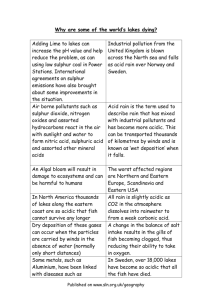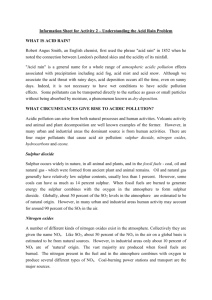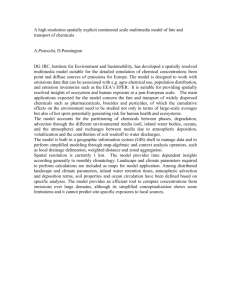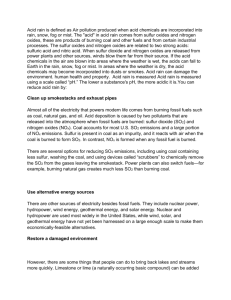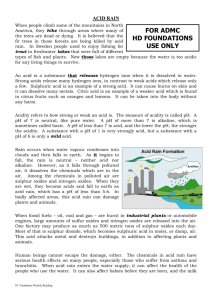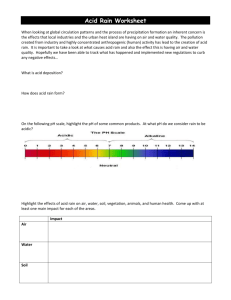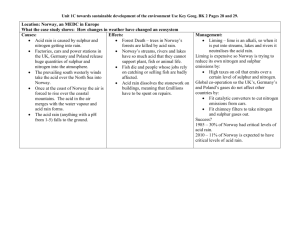Acid Deposition - University of Liverpool
advertisement
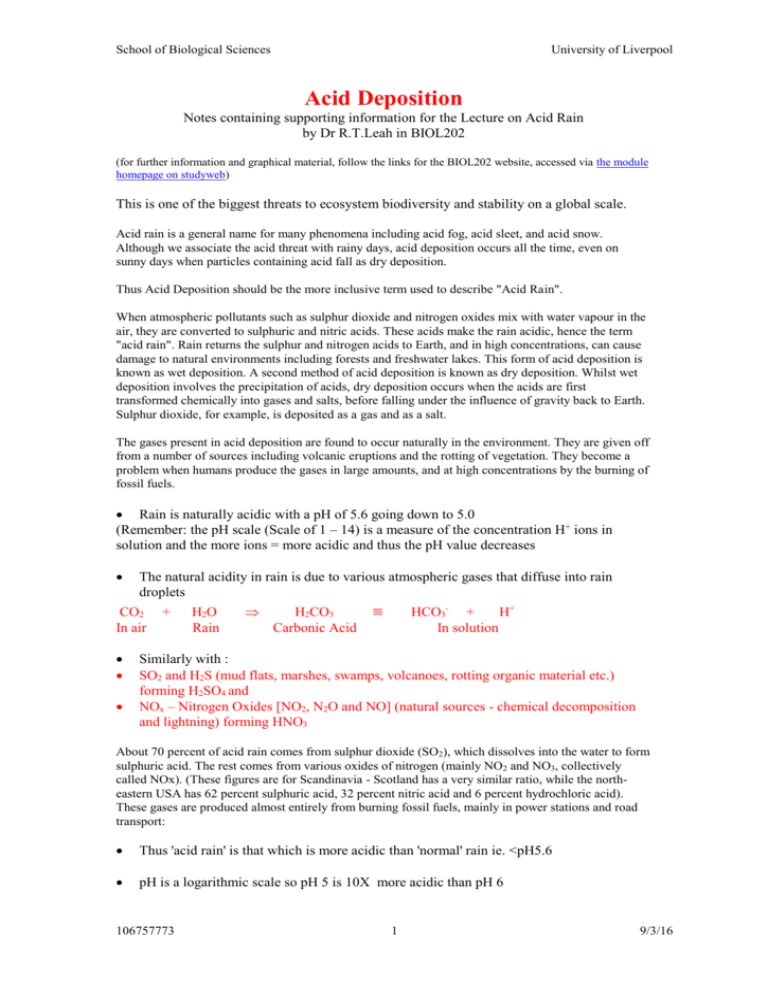
School of Biological Sciences University of Liverpool Acid Deposition Notes containing supporting information for the Lecture on Acid Rain by Dr R.T.Leah in BIOL202 (for further information and graphical material, follow the links for the BIOL202 website, accessed via the module homepage on studyweb) This is one of the biggest threats to ecosystem biodiversity and stability on a global scale. Acid rain is a general name for many phenomena including acid fog, acid sleet, and acid snow. Although we associate the acid threat with rainy days, acid deposition occurs all the time, even on sunny days when particles containing acid fall as dry deposition. Thus Acid Deposition should be the more inclusive term used to describe "Acid Rain". When atmospheric pollutants such as sulphur dioxide and nitrogen oxides mix with water vapour in the air, they are converted to sulphuric and nitric acids. These acids make the rain acidic, hence the term "acid rain". Rain returns the sulphur and nitrogen acids to Earth, and in high concentrations, can cause damage to natural environments including forests and freshwater lakes. This form of acid deposition is known as wet deposition. A second method of acid deposition is known as dry deposition. Whilst wet deposition involves the precipitation of acids, dry deposition occurs when the acids are first transformed chemically into gases and salts, before falling under the influence of gravity back to Earth. Sulphur dioxide, for example, is deposited as a gas and as a salt. The gases present in acid deposition are found to occur naturally in the environment. They are given off from a number of sources including volcanic eruptions and the rotting of vegetation. They become a problem when humans produce the gases in large amounts, and at high concentrations by the burning of fossil fuels. Rain is naturally acidic with a pH of 5.6 going down to 5.0 (Remember: the pH scale (Scale of 1 – 14) is a measure of the concentration H+ ions in solution and the more ions = more acidic and thus the pH value decreases The natural acidity in rain is due to various atmospheric gases that diffuse into rain droplets CO2 In air + H2O Rain H2CO3 Carbonic Acid HCO3- + H+ In solution Similarly with : SO2 and H2S (mud flats, marshes, swamps, volcanoes, rotting organic material etc.) forming H2SO4 and NOx – Nitrogen Oxides [NO2, N2O and NO] (natural sources - chemical decomposition and lightning) forming HNO3 About 70 percent of acid rain comes from sulphur dioxide (SO 2), which dissolves into the water to form sulphuric acid. The rest comes from various oxides of nitrogen (mainly NO 2 and NO3, collectively called NOx). (These figures are for Scandinavia - Scotland has a very similar ratio, while the northeastern USA has 62 percent sulphuric acid, 32 percent nitric acid and 6 percent hydrochloric acid). These gases are produced almost entirely from burning fossil fuels, mainly in power stations and road transport: Thus 'acid rain' is that which is more acidic than 'normal' rain ie. <pH5.6 pH is a logarithmic scale so pH 5 is 10X more acidic than pH 6 106757773 1 9/3/16 School of Biological Sciences University of Liverpool In the UK rain is often pH 4.1 to 4.7 i.e. 10 – 70 times more acidic than the 5.6 normal rain However values have been measured down to pH 2.4 in Pitlochry Scotland 1974. What Causes The Extra Acidity? Essentially the extra SO2 and NOx put into atmosphere by man Combustion of fossil fuels is main cause of extra SO2 All fuel has sulphur in it and when burnt some is left behind as the element but a lot combines with O2 in the combustion process to form SO2 Rises out of chimney and into atmosphere Remember that just because smoke 'disappears' does not mean that the pollution has disappeared - it has just been diluted As for Nitrogen Oxides NOx there are 3 main substances involved: Nitrous Oxide N2O Nitric oxide (NO) Nitrogen dioxide (NO2) NO tends to be oxidised to NO2 All can come from vehicle engines and power stations burning fuel Estimates are that SO2 contributes about 70% of extra acidity and NOx about 30% although this balance is now shifting as sources are cleaned-up in response to recent legislation Balance of natural gases to anthropogenic gases is overall about 50 : 50 however over Europe and Eastern North America the balance is more like 10 : 90 Acidic Emissions Rain water is naturally acidic as a result of carbon dioxide dissolved in water and from volcanic emissions of sulphur. However, it is the chemical conversion of sulphur and nitrogen emissions from power stations, factories, vehicles and homes, where fossil fuels are burnt, that we call acid rain. These waste gases are carried by the wind, sometimes over long distances, and can in time be converted into sulphuric and nitric acids. Natural sources of sulphur dioxide (SO2) include releases from volcanoes, oceans, biological decay and forest fires. Actual amounts released from natural sources in the world are difficult to quantify; in 1983 the United Nations Environment Programme estimated a figure of between 80 million and 288 million tonnes of sulphur oxides per year. Man-made sulphur dioxide emissions result from combustion or burning of fossil fuels, due to varying amounts of sulphur being present in these fuels. Worldwide emissions of SO2 are thought to be around 79 million tonnes per year. Levels of sulphur dioxide from combustion sources in the UK have declined in recent decades. Between 1970 and 1995, UK sulphur dioxide emissions fell by over 60% due to recession, restructuring of industry, substitution of fuels (for example natural gas) and air pollution control technology. Power station emissions fell by 45% over the same period, but the percentage of UK emissions from power stations has actually increased to 65% of the 1996 total compared to 45% of the total in 1970. Natural sources of nitrogen oxides (NOx) include volcanoes, lightening strikes and biological decay. Estimates range from between 20 million and 90 million tonnes per year NOx released from natural sources, compared to around 22 million tonnes from human sources world-wide. Nitrogen oxides are produced when fossil fuels are burned. The major sources of nitrogen oxides in the UK in 1996 were road transport (47%), power stations (22%) and industry (10%, including iron and steel, and refineries). Emissions of nitrogen oxides from road transport have steadily increased over recent years. For example, in 1970, emissions of nitrogen oxides from road transport in the UK were 634,000 tonnes but in 1989 they had risen to over 1.37 million tonnes. Since then, however, emissions from transport have 106757773 2 9/3/16 School of Biological Sciences University of Liverpool been declining due to improvements in vehicle technology, such as the use of catalytic converters, and the use of cleaner fuels. In 1996 nitrogen oxides emissions has fallen to 0.97 million tonnes. The geographical distribution of human acidic emission sources is not even. Nitrogen and sulphur emission sources are heavily concentrated in the Northern Hemisphere, particularly in Europe and North America. As a result, precipitation is generally more acidic in these countries, with an acidity in the range pH 4.1 to pH 5.1. 'Normal' or 'unpolluted' rainfall has a pH of 5.6. Unsurprisingly the industrial revolution and the coal and oil combustion of that started the real problems off Initially low chimneys and beginning of the problem meant that acid deposition was a fairly local event around industrial towns like Manchester, Leeds, Sheffield etc. Start of 1900s about 10 million tonnes of SO2 were pumped into the air over western Europe The recession of 1930s helped slow things down However from the 50’s emissions increased again and were also pumped higher into atmosphere because chimneys became taller. By 1970 25 million tonnes were being released into higher atmosphere each year So real effects of acid rain have been noted from 50s on although indications and effects were there from the 1900s. Fig - Sources of Acid Gases So Where Does It Go ? Once in the atmosphere the gases can travel by the wind SO2 can remain in the air for about 4 days and in that time it can be blown up to 2000 miles away 17% of the acid deposition of Norway derives from the UK (only about 7-10% of the acidity falling on Norway is generated by Norwegians) However the majority of emissions deposits closer to the source so that most deposition occurs in the most industrialised areas of Europe There are four main routes to the ground: 106757773 3 9/3/16 School of Biological Sciences University of Liverpool Wet deposition Gases react with water and form acidic rain, snow, sleet etc. It then falls to earth as Rainout Alternatively non-acidic rain can fall and as it passes through the air below where gases may be material is swept out and down = Washout Dry deposition In dry atmosphere photochemical reactions involving the highly reactive oxidising agent – Ozone results in further acid formation Although this is slower than wet reactions it is still a major effect in some locations The acid then falls as gaseous or particulate form to earth Occult deposition When gases react with moisture held in mists and fogs Ozone and Photochemical Smog Photochemical smog, the yellowish-brown haze of hot summer days, is formed when nitrogen oxides (NOx) and volatile organic compounds (VOCs) react in the presence of sunlight. NOx are released mainly from the burning of fossil fuels, whereas VOCs are emitted in gasoline fumes, and in the evaporation of solvents. Ground-level ozone, distinct from the protective ozone layer in the stratosphere and a major component of smog, is the primary end product of the reactions between NOx and VOCs. Ozone is hazardous to human health. The effects of breathing ozone include coughing, discomfort and decreased lung capacity. Studies suggest that over the long-term, exposure to ozone may lead to increased susceptibility to respiratory illnesses, and premature aging of the lungs. Ozone also damages vegetation, thereby lowering crop productivity. (The resulting economic losses are estimated at up to $70 million per year in Ontario and $9 million in British Columbia, depending on the severity of ozone episodes during the growing season. Beans, tomatoes, tobacco, potatoes, soya beans and wheat are all very sensitive to ozone. In order to protect human health and vegetation, Canada has set its maximum acceptable level of ozone at an average of 82 parts per billion (ppb) for one hour (this 82 ppb acceptable level is being reconsidered as part of the Canada-Wide Standards setting process). During especially hot summers, concentrations of ozone in parts of Ontario and Quebec can be more than double the air quality standard of 82 ppb.) In 1988, the Canadian Council of Ministers for the Environment set up the NOx/VOC Management Plan to resolve Canada's ozone problem by the year 2005. The plan identified three areas in Canada that are particularly affected by smog: the Lower Fraser Valley in B.C., the Windsor-Quebec City Corridor and the Southern Atlantic Region. Scientific research into smog formation has been an integral part of the Plan, which is now in its third phase. The Branch has taken a lead role by examining the chemical processes that produce smog, by monitoring concentrations of the pollutants on a regional scale, and by developing models to evaluate control options. Complexity - Determining Trends Like much environmental data, data on the concentration of acidity in the environment is very variable on a daily, monthly or annual basis. What is important is to determine the trend over longer periods of time. An example of changing (decreasing) sulphate concentration in rain over Nova Scotia is seen below. 106757773 4 9/3/16 School of Biological Sciences University of Liverpool Fig2 Trend of Sulphate concentration in rain (Nova Scotia) (XSO4 because there are a number of cations which may be linked to the SO4) What are the Effects of the deposition? This depends on whether it falls on land or water Soils Soil is the basis of wealth upon which all land-based life depends. Acid deposition is known to wash essential nutrients from soils, and aluminium which is normally bound in the soil may be released into ground water. Soil acidification may affect the health of trees and other vegetation. Soils containing calcium and limestone are more able to neutralise sulphuric and nitric acid depositions than a thin layer of sand or gravel with a granite base. If the soil is rich in limestone or if the underlying bedrock is either composed of limestone or marble, then the acid rain may be neutralised. This is because limestone and marble are more alkaline (basic) and produce a higher pH when dissolved in water. The higher pH of these materials dissolved in water offsets or buffers the acidity of the rainwater producing a more neutral pH. In regions where the soil is not rich in limestone or if the bedrock is not composed of limestone or marble, then no neutralising effect takes place, and the acid rainwater accumulates in the bodies of water in the area. This applies to much of the north-eastern United States where the bedrock is typically composed of granite. Granite has no neutralising effect on acid rainwater. Therefore, over time, more and more acid precipitation accumulates in lakes and ponds. Such areas or catchments are termed acidsensitive (poorly buffered), and can suffer serious ecological damage due to acid rain. To grow, trees and other vegetation need healthy soil to develop in. Long-term changes in the chemistry of some sensitive soils occur as a result of acid rain. As acid rain moves through the soils, it can strip away vital plant nutrients such as calcium, potassium and magnesium through chemical reactions, thus posing a potential threat to future forest productivity. Furthermore, the number of micro-organisms present in the soil also decreases as the soil becomes more acidic. This further depletes the amount of nutrients available to plant life because the micro-organisms play an important role in releasing nutrients from decaying organic material. Trees growing in acidified soil are more susceptible to viruses, fungi and insect pests. Other plant life may grow more slowly or die as a result of soil acidification. Poisonous metals such as aluminium, cadmium and mercury are leached from soils through reacting with acids. This happens because these metals are bound to the soil under normal conditions, but the added dissolving action of acids causes rocks and small-bound soil particles to break down. In addition, 106757773 5 9/3/16 School of Biological Sciences University of Liverpool the roots of plants growing in acidic soil may be damaged directly by the acids present. Finally, if the plant life does not die from these effects, then it may be weakened enough so that it will be more susceptible to other harsh environmental influences like cold winters or high winds. Forests Some trees are more sensitive than others Some are higher up so have more direct rain or even sit in rain clouds Some are more exposed to wind or are taller than surrounding trees so get more acid deposited on them Evergreens are more susceptible than deciduous because they don’t rid their leaves in autumn Trees Acid rain can have serious impacts on trees and forests. Acid rain does not usually kill trees directly. Instead, it is more likely to weaken them by damaging their leaves, limiting the nutrients available to them, or poisoning them with toxic substances slowly released from the soil. The main atmospheric pollutants that affect trees are nitrates and sulphates. Forest decline is often the first sign that trees are in trouble due to air pollution. Scientists believe that acidic water dissolves the nutrients and helpful minerals in the soil and then washes them away before the trees and other plants can use them to grow. At the same time, the acid rain causes the release of toxic substances such as aluminium into the soil. These are very harmful to trees and plants, even if contact is limited. Forests in high mountain regions receive additional acid from the acidic clouds and fog that often surround them. These clouds and fog are often more acidic than rainfall. When leaves are frequently bathed in this acid fog, their protective waxy coating can wear away. The loss of the coating damages the leaves and creates brown spots. Leaves turn the energy in sunlight into food for growth. This process is called photosynthesis. When leaves are damaged, they cannot produce enough food energy for the tree to remain healthy. Once trees are weak, diseases or insects that ultimately kill them can more easily attack them. Weakened trees may also become injured more easily by cold weather. While forestry has long been considered to be adversely affected by acid rain, recent studies show it to also be part of the acidifying process. The rough canopies of mature evergreen forests are efficient scavengers of particulate and gaseous contaminants in polluted air. This results in a more acidic deposition under the forest canopies than in open land. Chemical processes at the roots of trees, evergreens in particular, further acidify the soil and soil water in forested catchments. When the forests are located on low-alkaline soils, these processes can lead to a significant acidification of the run-off water and consequent damage to associated streams and lakes. The canopy onto which the rain falls buffers (neutralises) about 35% of the acids This happens because trees transport alkaline ions from the soil through the trunk to the leaves As a result the soil becomes more acidic as these base cations (Mg, Ca, Na and K) are removed Also means less of these base cations get washed into aquatic systems This is without any acid actually falling on the ground itself however Some acid falls on the trunk or branches or directly on the ground Once in the ground the acids react with rocks releasing toxic metals such as mercury, copper, aluminium and cadmium. Aluminium is particularly important but Soil is as rain is naturally acidic but the organic and carbonic acids in soil are weak acids and do not chemically dissociate into there respective cations and anions like the strong acids in acid deposition It is these strong acids and their dissociation that allows the release of metals from rocks etc. 106757773 6 9/3/16 School of Biological Sciences University of Liverpool Some of these toxic metals are absorbed by the tree roots whilst the rest washes into the aquatic system along with actual acidic ions i.e. H+ Nutrients from within the soils are also washed out Eventually there is nothing to neutralise the acid and the tree dies Often before the trees dies of acid damage its weakened defences can not withstand natural attacks from fungi, drought, beetles, frost etc. so dies Either way the trees die and the land is left acidified Should be noted that area rich in alkaline soils i.e. limestone CaCO3 have such a huge acid “Buffering Capacity” that acid damage here is far less But of course more hilly and mountainous areas i.e. where the most acid deposition occurs, tend to have thin soils with a lower “Buffering Capacity” As said evergreens are more susceptible because they don’t shed their leaves So apart from the actual trees suffering more the effects to the land are greater because the tree defence mechanisms are used more i.e. more alkaline ions are removed etc. Unfortunately from a forestry perspective coniferous evergreens yield more profit than deciduous trees like oak An oak takes 150 years to produce 5 cubic metres per hectare Conifers take 50 years and produce 18 m3 ha-1 Therefore conifers are grown and in the UK over 60% of our 2 million hectares of woodland is coniferous Therefore the effect of acid rain is greater than it would be (too both trees and land) if our forestry practices were different Also because in a natural system some of the ions that are removed from the ground by the trees typically return to the ground when the tree dies and rots In agri-forested land the trees are removed so nothing returns to the ground. Further enhancing the ill effects of acid rain So many of Europe's trees are damaged. In some countries over half of all the trees show signs of acid damage Somewhere between £60 and £250 million of tree loss occurs in the EC each year Estimates are difficult to get but it’s a huge amount of money Monuments and Buildings The acid (typically from dry deposition in the area around the source) can attack buildings, corroding limestone, sandstone, marble, concrete metal and mortar Historic buildings are all too often damaged in this way Estimated that Europe spends over £2000 million pounds a year on corrosion prevention costs alone. As well as the defacing of many ancient and beautiful monuments which could be valued as priceless St Pauls in London for instance has had over an inch of stone eroded away in places The Statue of Liberty in New York, The Taj Mahal in India and The Acropolis in Athens are all being attacked in similar ways The overall cost on corrosion prevention, material damage, work etc. is a staggering £1 to £5 billion per year in Europe. Human Health Corrosive and poisonous smog can hang over cities (LA) and in mid part of 1900s London This increases respiratory disease and illness – especially in the old 106757773 7 9/3/16 School of Biological Sciences University of Liverpool In December 1952 in London smog descended and stayed for four days It has been estimated that indirectly (through illness) it caused the death of 4000 people It resulted in the Clean Air Act of 1956 Domestic coal fires were banned through most of London Factories had to remove the black dust from their smoke Industry that used huge amounts of coal (power stations) had to build towers to transport the smoke away from London Didn’t do anything about SO2 unfortunately although they had then and still do have the technology to remove all SO2 emissions Today direct deaths are rare but it is estimated that due to health care costs, loss of work, government benefits etc. £1000 million is spent or lost in the UK each year indirectly due to acid deposition Also life expectancy is reduced by up to a year Chimneys & Stacks Although media attention has shifted towards other environmental issues such as global warming, acid deposition continues to be a problem at the beginning of the 21st century. In fact, acid rain is not a new problem at all. It dates from the middle of the 19th century when a Scottish chemist, Robert Angus Smith, began to study the effect of air pollution in Manchester, UK, and used the term 'acid rain' to describe his findings. What is very new is the scale of the problem. In Smith's time, acid rain fell both in towns and cities and downwind from them, but now, the pollution is spread far and wide, within and between nations. It has now become an international or trans-boundary problem. In December 1952 the Great London Smog accounted for over 4,000 deaths due to high levels of smoke and sulphur dioxide pollution. To prevent such a catastrophe ever occurring again, the UK Government passed two Clean Air Acts, the first in 1956 and the second in 1968. The Clean Air Act of 1968 brought in the basic principle for the use of tall chimneys or stacks for industries burning solid, liquid or gaseous fossil fuels. At the time of this legislation it was recognised that smoke pollution could be controlled, but that sulphur dioxide removal was generally impracticable. Hence, the higher the chimney, the better the dispersal of the air pollution. Urban air quality improved following the Clean Air Acts. Research into and monitoring of airborne pollutants reinforced the view that tall chimneys ensured adequate dispersion in the atmosphere, reducing significantly the amount of sulphur dioxide and nitrogen oxides pollution at ground level. However, concern grew regarding the eventual fate in the atmosphere of the pollution emitted. Aircraft measurements in the 1970s revealed that as much as 70% of sulphur dioxide emitted in the UK was leaving the country. It became clear that this pollution was the primary cause of the acidification of thousands of freshwater lakes in Scandinavia, and the damage to hundreds of thousands of trees. Whilst chimneys and stacks are still used today to disperse pollution from fossil fuel burning, sulphur dioxide and nitrogen oxides pollution from power stations and industry has been falling since the 1990s as a consequence of improved emission control technology in response to international agreements on transboundary pollution negotiated in the 1970s and 1980s. Critical Loads Critical loads have been defined as: "the highest load that will not cause chemical changes leading to long-term harmful effects in the most sensitive ecological systems". Critical loads are the maximum amount of pollutants that ecosystems can tolerate without being damaged. The definition has been redrafted in order to fit specialist areas of interest, most particularly the acidification of freshwater and soils. The concept behind critical loads is based upon a dose-response relationship where the threshold of harmful response (within the ecosystem) is triggered by a certain load of pollutant - the critical load. However, it is not always easy to apply without careful consideration of the nature of the affected ecosystem and the threshold effects of harmful pollutants. In order for critical loads to be used, target loads need to be set for different areas in order to try and halt the acidification processes. Target loads 106757773 8 9/3/16 School of Biological Sciences University of Liverpool have been defined as "the permitted pollutant load determined by political agreement". Therefore, target loads can be either higher or lower than the critical load values. For example, the target load may be lower so as to give a safety margin or the target load may be higher for economic reasons. The reasoning behind this is that critical loads only show where there is an acidification problem and to what degree damage is occurring. Target loads are used in order that emissions can be reduced accordingly to meet the targets and limit the amount of damage. The critical loads for total acidity of sulphur and nitrogen need to be determined so that a coherent international agreement can be reached with regard to abatement policies. There are numerous methods that are available for obtaining critical loads. In order to obtain values for the critical loads, an ecosystem has to be chosen and then a suitable indicator species is selected to represent the ecosystem. A chemical limit is subsequently defined as the concentration at which the indicator species will die. In forests the indicators are trees, and in freshwaters they are fish. Through the Convention on Long-Range Transboundary Pollution, member countries of the United Nations Economic Commission for Europe (UNECE) agreed that the critical loads approach provided an effective scientific approach for devising strategies for the abatement of acid deposition. The UK Government accepted that the critical loads approach was the best way to establish abatement strategies in relation to sulphur dioxide and nitrogen oxides emissions. It was recognised that critical loading maps were essential in providing information on the geographical distribution of pollutant-sensitive locations. The Critical Loads Advisory Group (CLAG) was set up to produce critical load maps for the United Kingdom. The National Centre for Critical Loads Mapping was subsequently established at the Institute for Terrestrial Ecology. Critical load maps of soil acidity have been produced for the UK at a grid resolution of 1 km squares. Maps for the critical acidity of freshwater environments are based on a single water sample from a single site in each of the 10 km squares used, assumed to be the most sensitive surface water within the grid square. These critical loads maps, when combined with acid deposition values, produce exceedance maps which show where and by how much the critical loads are being exceeded. Maps are available for soils in the UK relating to acidity and sulphur deposition showing areas that are sensitive to acidification. These correspond to areas where there have been reports of acidification. In the UK a national target load map for the year 2005 has been produced for soils on a 20km by 20km grid system, showing the target loads that need to be met for such areas. Aquatic Systems – Where Does The Acid Come From? As inferred earlier, there are three ways that extra acidity can enter aquatic systems 1. Direct from the atmosphere – either as dry or wet deposition 2. Indirectly from the atmosphere via run-off in the catchment 3. From generation of acidity within the catchment – i.e. when soil becomes more acidic as a result of trees buffering the acid on their canopy by using base cations from soils and therefore making the soil more acid i.e. Soil Acidification Also as mentioned you can get metals such as Cd, Al, Cu etc. mobilised as well as increased nutrients from soils and rocks entering streams and lakes. These effects are magnified when coniferous trees are present because these evergreen trees try and buffer the acids in the canopy for longer periods of time. Deciduous trees shed their leaves in autumn often before a lot of rain and snow fall and therefore do not remove as much of the base cations from the soil etc. The impact of forestry has been studied by comparing drainage from unforested and 100% forested catchment. pH falls rapidly in streams as soon as 10%+ coniferous trees are present Can also see that Al3+ and SO42- are also increased 106757773 9 9/3/16 School of Biological Sciences University of Liverpool Long And Short Term Changes In The Acidity Of Freshwaters The effect of acid deposition depends on how the acid gets into the river or lake in the first place. There are essentially two types of acidic input Long Term Inputs This is a long and continual input of acidic compounds into the system pH in aquatic systems has been decreasing for centuries but markedly since mid 1900’s Sulphur compounds were the prime cause of this but these are now slowly decreasing (tougher / cleaner legislation) N compounds are still increasing and becoming more important cause of acidification N compounds are up because of increased car use Therefore there are long term effects of a continual input of acid into aquatic systems – a continual removal of alkalinity from the system which could only be replaced on a geological timescale There are also shorter term inputs and these although not as long lived can have more pronounced effects over a short space of time Short Term Inputs Short term inputs are often related in some way to seasonal changes within the systems EFFECTS OF ACID RAIN ON AQUATIC ECOSYSTEMS Using Cnadian Lakes as an example: Ontario lakes are abnormally sensitive to acid rain because of the hard bedrock of the Canadian Shield and the poor soil cover which has little to no buffering ability. The effects of acidic rain started showing up in the 1970's. Fish were washing up along the beaches, and the term "wet desert" was being used to describe the clear, fishless lakes. For example, Ontario now has over 100 fishless and acidified lakes. Many types of species such as the lake trout, the wall-eye, burbot and the smallmouth bass have nearly vanished from most of these lakes. Recent reductions in Air Pollution over North America are beginning the long, slow process of recovery. Starting in 1981, over 200 lakes were monitored in Ontario, Quebec alone and the Atlantic Provinces, and in 1994, 33% showed some marked improvement in acidity while over 10% were worse. The remaining 56% had at least stable acidity levels. Impacts on Aquatic Biota As acidity increases in an ecosystem, there is differential impact on the various taxonimic groupings present which alters ecosystem composition and functioning. It is unusual for direct toxicity to occur causing death by acute poisoning, it is more usual that community composition changes slowly as growth and survival of individuals declines and reproductive success decreases to zero. 106757773 10 9/3/16 School of Biological Sciences University of Liverpool Impacts on Fish It was first believed that the fish deaths were caused by the acids themselves, however, research has since shown that the high levels of metals especially aluminum (a toxic heavy metal) that were leached from the soil, was the real cause of the deaths of the fish. Aluminum can be acutely toxic to fish at pH levels that are not even close to being toxic to man. A concentration as low as 6.2mg/L is known to kill fish Aluminum kills fish in at least two ways. First, it is able to reduce the ion exchange through the gills causing salt depletion. Aluminum also precipitates in the gills and interferes with the normal transport of oxygen and other ions, so that the fish dies of a lack of oxygen. In addition, the fish will exude mucus to combat the aluminum in their gills. This mucus builds up and clogs the gills so that oxygen and salt transport can not occur. Research has shown that dead fish had low levels of both Na+ and Cl- in the blood. This means that they were unable to regulate their salts in the body. What can we do? The best approach to acid rain is to reduce the amount of NOx and SO 2 being released into the atmosphere. Fitting a catalytic converter to a car can reduce the emissions of NOx by up to 90 percent, but they are very expensive, and cause more carbon dioxide to be released, which contributes to the greenhouse effect. SO2 emissions from power stations can be reduced before, during, or after combustion. If a fuel with a low sulphur content (such as North Sea gas or oil) is burned, not much sulphur dioxide will be formed. However, low sulphur fuels are more expensive because they are in greater demand, and although high-suphur fuels can be treated to reduce their sulphur content, this is very expensive. The SO2 created during combustion can be absorbed if an appropriate chemical (such as limestone) is present as the fuel burns. Once the fuel has been burned, the SO2 can be removed from the exhaust gases. Most systems spray a mixture of limestone and water onto the gases. This mixture reacts with the SO 2 to form gypsum, a useful building material. Another option is not to burn fossil fuels, but to use alternative energy sources. 106757773 11 9/3/16 School of Biological Sciences University of Liverpool All these methods for reducing acid gases are expensive, and have drawbacks, so laws have been passed to force businesses to use them. The best way to reduce them is not to use as much energy in the first place. International Agreements Because pollutants can be carried many hundreds of kilometres by winds, acid pollutants emitted in one country may be deposited as acid rain in other countries. Acid deposition has become an international problem. This problem is highlighted by the fact that emissions of a particular pollutant from one country does not equal the deposition of that pollutant in the same country. Some countries emit small quantities of pollutants yet deposition can be several times greater. Other countries emit more pollution than is deposited in their country because of prevailing wind directions. In 1979, the United Nations Economic Commission for Europe (UNECE) implemented the Convention on Long-Range Transboundary Pollution. In 1985 most UNECE members adopted the Protocol on the Reduction of Sulphur Emissions, agreeing to reduce sulphur dioxide emissions by 30% (from 1980 levels) by 1993. This was called the 30% club. All of the countries that signed the Protocol achieved this reduction, and many of those that did not sign, have met these reductions. In June 1994, a number of European countries signed the Second Protocol for sulphur. Most of the western European countries agreed to reduce sulphur emissions by between 70 and 80% by the year 2000 (against 1980 levels) whilst eastern European countries generally have a lower target of between 40 and 50% (against 1980 levels). Overall, emissions of sulphur dioxide in Europe are estimated to have fallen by 25-30% between 1980 and 1990, and by 40% by the year 2000. Further falls in sulphur dioxide emissions are expected over the next decade. The Sofia Protocol for reducing nitrogen oxide emissions was adopted in 1988. This required all countries that signed the Protocol to stabilise emissions of nitrogen oxide (against 1987 levels), although some countries committed themselves to 30% reductions by 1998 (against levels of any year between 1980 and 1986). However, many of these countries are unlikely to meet these targets, due to increases in road traffic, despite European Union legislation requiring cars built after 1993 to be fitted with a catalytic converter. In 1988 a Directive was introduced for European Community (EC) countries which required power stations to reduce emissions of sulphur dioxide and nitrogen oxides. For the UK, reductions of sulphur dioxide by 60% by 2003 and nitrogen oxides by 30% by 1998 (against 1980 levels) have been set. The UK is well on course to exceed both targets through new gas-fired power stations (which have lower emissions) replacing coal fired power stations, and flue gas desulphurisation equipment fitted to some of the existing coal-fired power stations. Liming The only sure way to prevent acidification of freshwater bodies is to reduce the emissions of acid pollutants in the first place. There is a relationship between sulphur and nitrogen emissions, acid deposition, acids in water run-off and loss of alkalinity. If acidification of freshwaters is to be prevented then the deposition of sulphur and nitrogen needs to be reduced. The technical means are available to reduce emissions, such as flue gas desulphurisation, low nitrogen oxides burners, use of low sulphur coal and oil and increasing energy efficiency. At present the main way of reversing acidification in freshwaters is liming the water body or its surrounding catchment. The main liming method is to add the lime directly to the water body. Liming of water directly, however, causes aluminium and other metals to come out of solution and fall to the bottom of the lake, causing toxicity problems for organisms living on the lake bed. Lime can be added to the catchment, although this can have an adverse effect on wetland species of plants. The advantages, however, are that the effects are longer lasting and metals are prevented from leaching into the lake water from the soil. The effects of liming are almost entirely favourable within the lake. The alkalinity of the lake is increased, the pH increased and heavy metal concentrations decrease back to within safe 106757773 12 9/3/16 School of Biological Sciences University of Liverpool limits for fish life. The number of species of fish and plankton increase as does the total production of living matter. Acidified lakes in Sweden have been restored in the short term by liming. Each year thousands of tonnes of limestone are sprayed on Swedish lakes and watercourses, by means of trucks, boats or helicopters. Liming on such a large scale, however, is expensive, costing million of pounds. Liming provides only a temporary solution, hence it is far better to attack the source of the problem by reducing emissions of acidifying pollutants. Vehicle Emission Controls Through emissions of nitrogen oxides, cars and other road vehicles are major contributors to acidic emissions which cause acid rain. In all countries of the industrialised world, the number of vehicles on the roads has been continually increasing since the 1970s. With a large rise in traffic numbers, it becomes increasingly important to keep pollutant emissions to a minimum. There are presently a number of ways in which road traffic pollution can be reduced, including the use of emission control technology solutions. Since January 1993, all new cars sold in the European Union have been fitted with a catalytic converter. Most catalytic converters lead to a dramatic reduction in emissions of nitrogen oxides, as well as other harmful pollutants. Exhaust Gas Recirculation involves returning exhaust air to the fuel inlet, which results in a reduction in peak engine temperatures and emissions of nitrogen oxides from petrol vehicles. Smaller, lighter cars use less fuel and hence produce less pollution. Technological development using lighter materials for construction may therefore reduce emissions. The above technologies all provide a reduction in emissions from vehicles. Electric transport is an alternative development that could lead to a large reduction in acidic pollution at ground level, if it became more wide spread. Electric transport produces no emissions at the point of use, although pollution is emitted during the production of electricity from power stations. The main drawback for electric vehicles is the need to recharge batteries. In addition, although they have lower fuel and maintenance costs than petrol and diesel, at present they require a higher capital investment. The technical fixes such as those outlined above need to be combined with management schemes to reduce traffic in city centres, education to encourage the public to use their cars less, and the further development of alternative fuels that are not harmful to the environment. For Additional Reading : This is an area where research is active and on-going, making it difficult to recommend texts in the traditional sense. However, there is a plethora of very good information on the web. Use the page of links on the BIOL202 Website on the the module homepage on studyweb) 106757773 13 9/3/16

